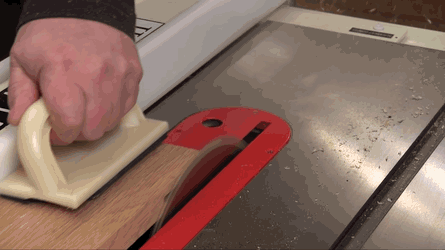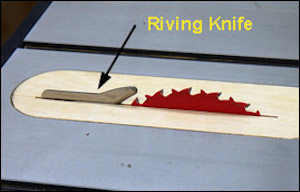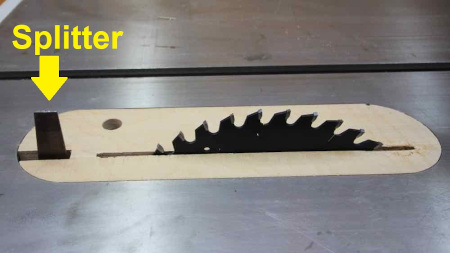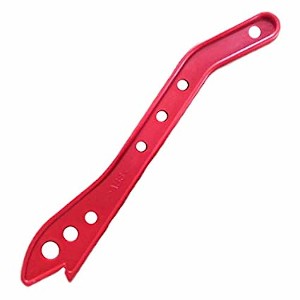Table saw kickback is a serious concern when using a table saw. A table saw spins the saw blade with A LOT of torque. It’s not an exaggeration to say that a table saw can kickback a large piece of wood 20 feet through a piece of sheetrock. You’ll want to stay out of harm’s way because you will be injured if that woodpiece hits you, or even grazes you. You’ll be lucky if you walk away with a bruise or a scratch.
Page Contents
What is Table Saw Kickback?

Kickback occurs when the workpiece gets pinched or pushed back onto the backside of the saw blade. The rear of the saw blade spinning so the blade is coming up towards the ceiling. The saw blade catches the wood, drags it over the top of the saw blade and fires it like a bullet back towards the direction the saw blade is spinning. Kicked back wood can come straight back, but usually, it will come off the blade at an angle away from where your fence would be. Here are some tips to prevent kickback on a table saw.
What is a Riving Knife and a Splitter?
Riving Knife

The hands down best way to prevent kickback is to make sure your table saw has a riving knife. A riving knife sits behind the saw blade and prevents a workpiece that has just been cut from making contact with the backside of the saw blade as it moves past. Most modern day table saws come with riving knives. Older table saws may not utilize one, but may have a splitter behind the saw blade. A riving knife prevents kickback when the table saw blade is at any height because it raises and lowers with the blade.

Splitter
Splitters are not common nowadays, as almost all table saws come with a riving knife. A splitter is not as good as preventing kickback as a riving knife. As a matter of fact, a splitter should never be considered safe unless the table saw blade is at its full height. Your table saw blade is not often going to be at full height to make a cut. It is more likely to be between full height and fully retracted, which creates a dangerous situation.
Why a Splitter Can be Dangerous
A splitter sits right at the rear of the table saw blade at full height, so when you lower the blade for shorter cuts, space can open up between the splitter and the blade. Space where your workpiece can be pinched back onto the tail end of the blade and kicked back at you. A splitter is better than having nothing at all, but a riving knife is ideal in preventing kickback.
Aligning the Saw Blade with the Fence
Another potential problem is the fence being out of alignment with the blade. The fence and the blade must be 100% parallel. This is one of the first things that should be checked when you purchase a new table saw. You should also check the alignment periodically. Even being off a tiny bit can cause a workpiece to get pinched between the fence and the blade and cause kick back.
Push Sticks

Another way to prevent kickback is by using push sticks on each side of the cut so the piece is pushed evenly past the blade. If you push from just one side, the workpiece is going to move toward the opposite side. This can cause it to get pinched between the fence and the blade and cause kickback. Put the push sticks close to the blade- one on the fence side and one on the open side. Push with even pressure on both sticks. This will help prevent the workpiece from getting pinched between the fence and the backside of the saw blade.
Planning and Safety Tips for Table Saw Kickback
Layout the Cut
Always layout the cut beforehand so you can foresee any potential problems. Make sure you can push the entire length of the cut into, through and past the blade. Check to see if there is anything that can block the workpiece before the cut is completed. Check for knots in the path of the cut. Cutting through a knot will relieve a lot of stress in that section of the wood, making it possible for the wood to move or flex back onto the table saw blade causing kickback. Make sure your saw blade is sharp, so you’re not forcing the wood through the cut.
Cutting Pieces Larger than the Table Saw
This is important if you are cutting large pieces. You relieve a lot of tension on the wood when you make a long cut. It’s easy for the workpiece to make contact with the rear of the blade and get kicked back. Make sure you have supports in front of and behind the table saw if you’re making cuts larger than the table can support. You want to keep the wood from flexing in any direction while making a cut.
Stand Clear of Potential Kickback
Keep clear of potential kickback. It’s not a way to prevent it but it’s a way to keep yourself out of harm’s way. Never stand directly behind what you are cutting. Stand to the side and use push sticks to push through the table saw blade. Any kickback is most likely to shoot straight back and away from the fence, so avoid standing in that area.
Now that you’ve gone over some ways to avoid injury, take a look at our tips on picking the right saw blade for your project.
